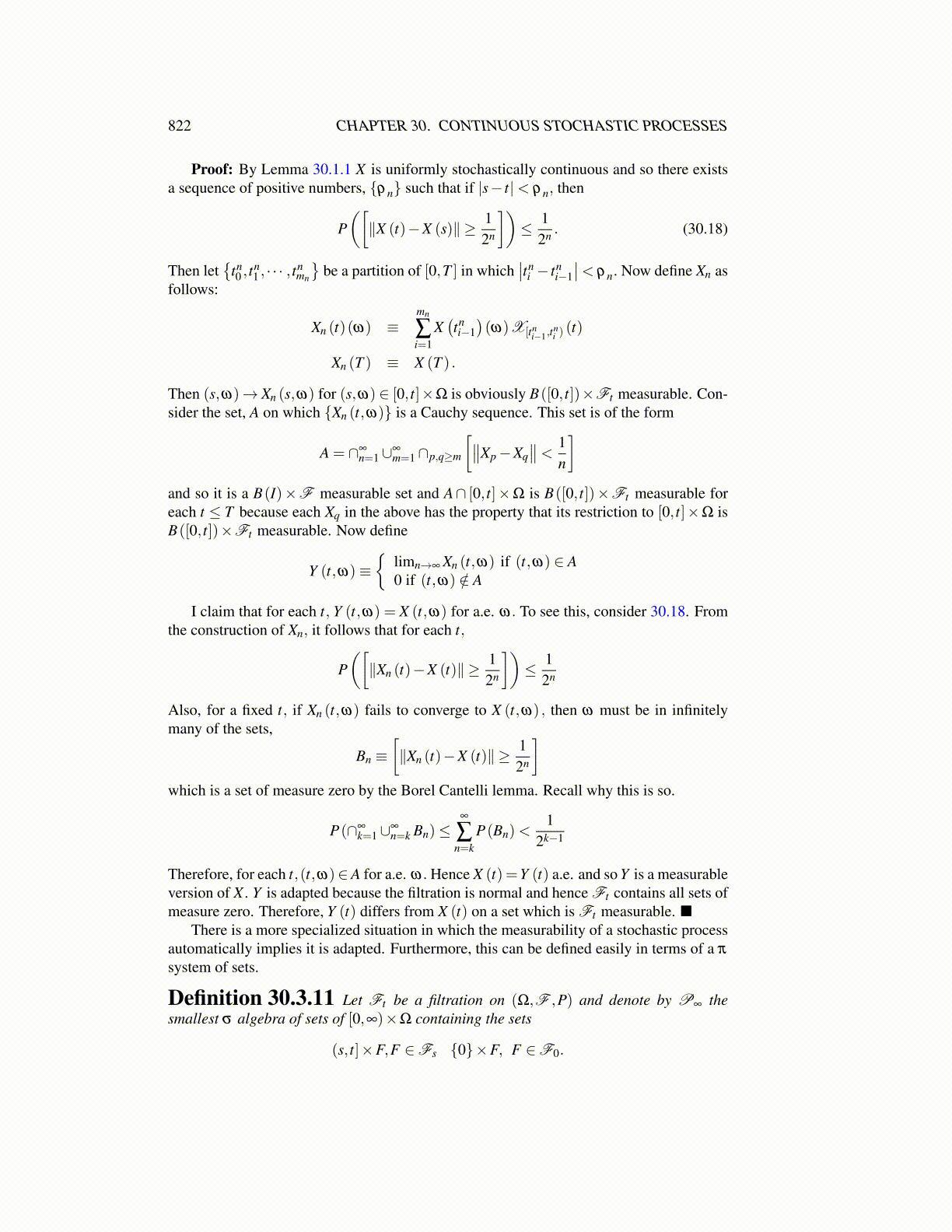
822 CHAPTER 30. CONTINUOUS STOCHASTIC PROCESSES
Proof: By Lemma 30.1.1 X is uniformly stochastically continuous and so there existsa sequence of positive numbers, {ρn} such that if |s− t|< ρn, then
P([∥X (t)−X (s)∥ ≥ 1
2n
])≤ 1
2n . (30.18)
Then let{
tn0 , t
n1 , · · · , tn
mn
}be a partition of [0,T ] in which
∣∣tni − tn
i−1
∣∣< ρn. Now define Xn asfollows:
Xn (t)(ω) ≡mn
∑i=1
X(tni−1)(ω)X[tn
i−1,tni )(t)
Xn (T ) ≡ X (T ) .
Then (s,ω)→ Xn (s,ω) for (s,ω) ∈ [0, t]×Ω is obviously B([0, t])×Ft measurable. Con-sider the set, A on which {Xn (t,ω)} is a Cauchy sequence. This set is of the form
A = ∩∞n=1∪∞
m=1∩p,q≥m
[∥∥Xp−Xq∥∥< 1
n
]and so it is a B(I)×F measurable set and A∩ [0, t]×Ω is B([0, t])×Ft measurable foreach t ≤ T because each Xq in the above has the property that its restriction to [0, t]×Ω isB([0, t])×Ft measurable. Now define
Y (t,ω)≡{
limn→∞ Xn (t,ω) if (t,ω) ∈ A0 if (t,ω) /∈ A
I claim that for each t, Y (t,ω) = X (t,ω) for a.e. ω. To see this, consider 30.18. Fromthe construction of Xn, it follows that for each t,
P([∥Xn (t)−X (t)∥ ≥ 1
2n
])≤ 1
2n
Also, for a fixed t, if Xn (t,ω) fails to converge to X (t,ω) , then ω must be in infinitelymany of the sets,
Bn ≡[∥Xn (t)−X (t)∥ ≥ 1
2n
]which is a set of measure zero by the Borel Cantelli lemma. Recall why this is so.
P(∩∞k=1∪∞
n=k Bn)≤∞
∑n=k
P(Bn)<1
2k−1
Therefore, for each t,(t,ω)∈A for a.e. ω. Hence X (t) =Y (t) a.e. and so Y is a measurableversion of X . Y is adapted because the filtration is normal and hence Ft contains all sets ofmeasure zero. Therefore, Y (t) differs from X (t) on a set which is Ft measurable. ■
There is a more specialized situation in which the measurability of a stochastic processautomatically implies it is adapted. Furthermore, this can be defined easily in terms of a π
system of sets.
Definition 30.3.11 Let Ft be a filtration on (Ω,F ,P) and denote by P∞ thesmallest σ algebra of sets of [0,∞)×Ω containing the sets
(s, t]×F,F ∈Fs {0}×F, F ∈F0.